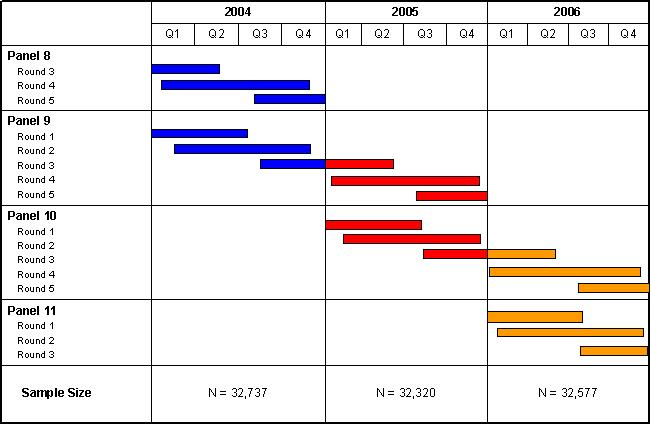MEPS-HC Panel Design and Data Collection
Process
The Household Component of the Medical Expenditure
Panel Survey (MEPS-HC) is a nationally representative survey of
the U.S. civilian noninstitutionalized population. The sampling
frame is drawn from respondents to the National Health Interview Survey,
which is conducted by the National Center for Health Statistics.
The MEPS-HC collects data from a nationally representative sample
of households through an overlapping panel design. A new panel
of sample households is selected each year, and data for each panel
are collected for two calendar years. The two years of data for
each panel are collected in five rounds of interviews that take
place over a two and a half year period. This provides continuous
and current estimates of health care expenditures at both the person
and household level for two panels for each calendar year.
The chart below illustrates the timing and relationship between panels, rounds, and calendar years. For example, looking at the data collection by panel, Panel 9 consists of five rounds of interviews; with Rounds 1–3 providing data for 2004 and Rounds 3–5 providing data for 2005. Looking at the data collection by year, data for the year 2005 consists of data collected from Rounds 3–5 of Panel 9 and Rounds 1–3 of Panel 10.
 Note: N is equal to the number of people
with a positive person weight on the file.
Note: N is equal to the number of people
with a positive person weight on the file.
Each round of MEPS-HC interviews collects information pertaining to a specific time period called a reference period. Using Panel 9 again as an example, the reference period for the first interview of Panel 9 began on January 1, 2004 and ended on the date of each reporting unit's Round 1 interview, conducted from March through June 2004. The reference periods for Rounds 2, 3, and 4 varied from household to household and covered the time between interview dates of the previous round and the current round. The last reference period of Panel 9 (Round 5) ended on December 31, 2005. (December 31st of the second calendar year is always the end of the last reference period.)
MEPS is a large-scale and comprehensive data collection effort
that includes many types of survey questions, some of which
only pertain to subsets of the diverse respondents participating
in the survey. To accommodate the extensive array of questions
covered, yet minimize the number of questions asked of each
respondent, data are collected using an intricate system
of skip patterns and questionnaire modules grouped into sections.
Computer-assisted personal interviewing (CAPI) using a laptop
computer makes it possible to field such a complex data collection
instrument.
Since data are collected using CAPI, rather than a hard copy
questionnaire, the data collection instrument actually consists
of sections that are composed of a series of computer screens
containing questions, interviewing instructions, and skip
pattern directions, as well as computer programming notes
embedded along with each data item. The MEPS data collection
in a given round consists of different sections. Some sections
are included in every round of data collection. Other sections
are only included in one or two rounds—this type
of section is also referred to as a supplement.
Any single question must be considered within the context
of the skip patterns incorporated into the questionnaire.
Some questions appear in several CAPI screens because of
the variety of skip patterns that lead to the question. The
question is only asked when the skip pattern determines that
it should be asked of that respondent. Items asking the same
question of various respondents typically map back to a single
variable in the database.
Click here to go to the
MEPS-HC survey questionnaires.
Suggested
Citation:
MEPS-HC Sample Design and
Collection Process. Agency
for Healthcare Research and Quality, Rockville, Md. http://www.meps.ahrq.gov/survey_comp/hc_data_collection.jsp
|
|
|

